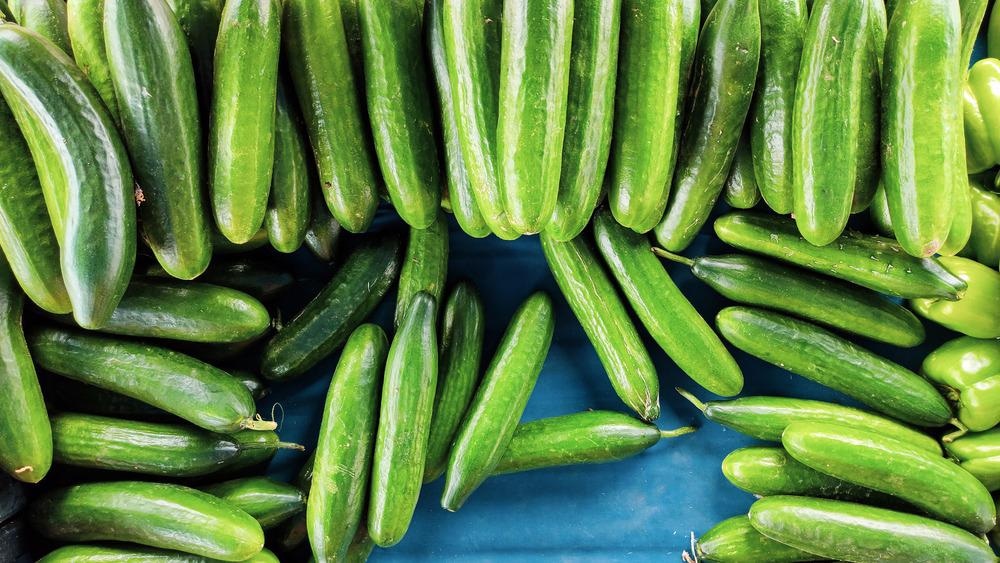 By Surbhi JainReviewed by Susha Cheriyedath, M.Sc.Mar 17 2022
By Surbhi JainReviewed by Susha Cheriyedath, M.Sc.Mar 17 2022In an article recently published in the Journal of Food Composition and Analysis, researchers discussed the development of a spectroscopic method for non-destructive and quick cucumber screening based on the maximum nitrate accumulation limit.

Study: Development of a spectroscopic approach for non-destructive and rapid screening of cucumbers based on the maximum limit of nitrate accumulation. Image Credit: M.C.A/Shutterstock.com
Background
Nitrogen is required for all plant and animal growth and reproduction. Proteins contain a large amount of nitrogen, and plant chlorophyll also contains nitrogen. As a result, a lack of nitrogen makes the leaves turn yellow and causes the plant to stop growing. Excessive nitrogen consumption causes the plant to develop rapidly and the leaves to turn a dark green tint. Plants absorb this nutrient in two forms: ammonium and nitrate. Because of the growing usage of nitrogen fertilizers in recent years, nitrate concentrations in vegetables have increased.
Because excessive nitrate accumulated in vegetables may pose a health concern, it is critical to monitor and determine the product's nitrate concentration during growing (to regulate fertilizer), sorting, and before supplying to the consumer (to ensure product safety and public health). As a result, non-destructive, low-cost, and quick procedures that are easy to use outside the laboratory are needed. Near-infrared (NIR) spectroscopy is such a non-destructive approach based on optical principles for displaying and measuring the composition of biological materials.
About the Study
In the present study, the authors discussed the development of a low-cost and non-destructive method based on visible (Vis)/NIR spectroscopy for quick assessment of the concentrations of nitrate in cucumbers and sample screening in context with the maximum nitrate accumulation limit. The spectra of intact cucumbers were studied in the Vis/NIR range, including field and greenhouse samples with varying nitrate contents.
The team used the reference measurements and pre-processed spectra to create partial least squares (PLS) models. Furthermore, principal component analysis-discriminant analysis (PCA-DA) classification models were developed using different Mahalanobis, linear, and quadratic methods to discriminate the samples as per the maximum limit of the accumulation of nitrate according to the sample type and as determined by the World Health Organization (WHO) and the Iranian National Standardization Organization (INSO).
The feasibility of Vis/NIR spectroscopy in the 450–1000 nm range was verified for screening cucumbers, including field and greenhouse samples from various growing seasons, based on nitrate contents.
The authors developed an optical method based on Vis/NIR spectroscopy for the non-destructive measurement of nitrate concentration in cucumber, a popular fruity vegetable in people's diet. The non-destructive discrimination of safe and unsafe cucumbers was assessed based on maximum nitrate accumulation limits set by both the INSO i.e., 90 mg kg-1 and WHO i.e., 150 mg kg-1. The non-destructive discrimination of greenhouse and field cucumbers based on Vis/NIR spectra was also illustrated.
Observations
The cucumbers were 86.26–188.02 mm, 35.09–114.53 g, and 22.18–35.90 mm in length, weight, and maximum equatorial diameter, respectively. Principal component analysis (PCA)-discriminant analysis (DA), a model based on Mahalanobis approach after pre-processing of MN+D1, was found to be appropriate for the categorization of unknown samples into two categories of "unsafe90" and "safe90", with sensitivity, accuracy, and specificity of 76.74%, 72.22%, and 54.55%, respectively.
The D2 pre-processing approach produced the best PLS model for predicting nitrate contents in cucumbers (standard error of prediction (SEP)=60.92 mg kg-1, the correlation coefficient of prediction (rp)=0.87, the ratio of performance to deviation (RPD)=2.07). Vis/NIR spectroscopy was shown to be adequate for screening cucumbers based on their nitrate amounts.
The results also showed that this technology, when combined with PCA-DA, was both appropriate (sensitivity=76.74%, accuracy=72.22%, specificity=54.55%) and fairly suitable (sensitivity=59.26%, accuracy=64.81%, specificity=70.37%) for screening cucumbers based on WHO and INSO maximum nitrate accumulation limits. It was also found to be an excellent technique for determining the type of cucumber (sensitivity=93.55%, accuracy=94.44%, specificity=95.65%).
The proposed technique was found to have significant potential to distinguish greenhouse cucumbers from field samples.
Conclusions
In conclusion, this study discussed the utility of Vis/NIR spectroscopy for the screening of cucumbers in the greenhouse and field throughout various growing seasons based on the concentration of nitrate. The proposed technology was found to be acceptable and useful for the initial screening of samples based on nitrate concentrations, despite the fact that reference methods for different repeats in nitrate measurements had large uncertainties, especially at high concentrations.
The authors emphasized that this method, in combination with PCA-supervised DA's pattern recognition, could be effective for screening cucumbers based on INSO's maximum nitrate accumulation limit. They also believe that the proposed spectroscopic method could be useful for determining the safety of cucumbers quickly and non-destructively, as well as constructing a portable screening system for usage outside of the lab.
Disclaimer: The views expressed here are those of the author expressed in their private capacity and do not necessarily represent the views of AZoM.com Limited T/A AZoNetwork the owner and operator of this website. This disclaimer forms part of the Terms and conditions of use of this website.
Source:
Jamshidi, B., Yazdanfar, N., Development of a spectroscopic approach for non-destructive and rapid screening of cucumbers based on the maximum limit of nitrate accumulation. Journal of Food Composition and Analysis 104513 (2022). https://www.sciencedirect.com/science/article/abs/pii/S0889157522001314